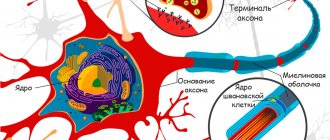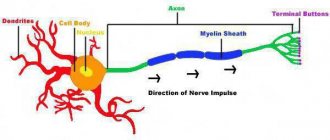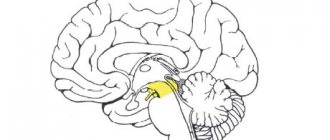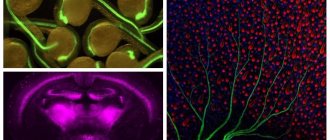Nerve impulses - the alphabet of the brain - are of an electrochemical nature
Magazine reader L. Gorbunova (village of Tsybino, Moscow region) writes to us: “I am interested in the mechanism of signal transmission through nerve cells.”
1963 Nobel Prize laureates (from left to right): A. Hodgkin, E. Huxley, D. Eccles.
Scientists' ideas about the mechanism of nerve impulse transmission have recently undergone significant changes. Until recently, Bernstein's views dominated science.
‹
›
The human brain is, without a doubt, the highest achievement of nature. A kilogram of nervous tissue contains the quintessence of the whole person, starting from the regulation of vital functions - the work of the heart, lungs, digestive tract, liver - and ending with his spiritual world. Here are our thinking abilities, our entire perception of the world, memory, reason, our self-awareness, our “I”. Knowing the mechanisms of how the brain works is knowing yourself.
The goal is great and tempting, but the object of research is incredibly complex. Just kidding, this kilogram of tissue represents a complex system of communication between tens of billions of nerve cells.
However, the first significant step towards understanding how the brain works has already been taken. It may be one of the easiest, but it is extremely important for everything that follows.
I mean the study of the mechanism of transmission of nerve impulses - signals running along the nerves, as if through wires. It is these signals that are the alphabet of the brain, with the help of which the senses send information-dispatches about events in the outside world to the central nervous system. The brain encodes its orders to the muscles and various internal organs with nerve impulses. Finally, individual nerve cells and nerve centers speak the language of these signals.
Nerve cells - the main element of the brain - are varied in size and shape, but in principle they have a single structure. Each nerve cell consists of three parts: a body, a long nerve fiber - an axon (its length in humans ranges from several millimeters to a meter) and several short branched processes - dendrites. Nerve cells are isolated from each other by membranes. But the cells still interact with each other. This happens at the junction of cells; this junction is called a “synapse”. At a synapse, the axon of one nerve cell and the body or dendrite of another cell meet. Moreover, it is interesting that excitation can be transmitted only in one direction: from the axon to the body or dendrite, but in no case back. A synapse is like a kenotron: it transmits signals in only one direction.
In the problem of studying the mechanism of a nerve impulse and its propagation, two main questions can be distinguished: the nature of the conduction of a nerve impulse or excitation within one cell - along a fiber, and the mechanism of transmission of a nerve impulse from cell to cell - through synapses.
What is the nature of the signals transmitted from cell to cell along nerve fibers?
People have been interested in this problem for a long time; Descartes assumed that the propagation of the signal was associated with the transfusion of fluid through the nerves, as if through tubes. Newton thought it was a purely mechanical process. When the electromagnetic theory appeared, scientists decided that a nerve impulse is analogous to the movement of current through a conductor at a speed close to the speed of propagation of electromagnetic oscillations. Finally, with the development of biochemistry, a point of view emerged that the movement of a nerve impulse is the propagation along a nerve fiber of a special biochemical reaction.
Yet none of these ideas came to fruition.
Currently, the nature of the nerve impulse has been revealed: it is a surprisingly subtle electrochemical process, which is based on the movement of ions through the cell membrane.
The work of three scientists made a major contribution to the discovery of this nature: Alan Hodgkin, professor of biophysics at the University of Cambridge; Andrew Huxley, Professor of Physiology, University of London, and John Eccles, Professor of Physiology, University of Canberra, Australia. They were awarded the Nobel Prize in Medicine for 1963.
The famous German physiologist Bernstein was the first to suggest the electrochemical nature of the nerve impulse at the beginning of this century.
By the early twentieth century, quite a lot was known about nervous excitation. Scientists already knew that a nerve fiber can be excited by electric current, and the excitation always occurs under the cathode - under the minus. It was known that the excited area of the nerve is charged negatively in relation to the non-excited area. It was found that the nerve impulse at each point lasts only 0.001-0.002 seconds, that the magnitude of excitation does not depend on the strength of the irritation, just as the volume of the bell in our apartment does not depend on how hard we press the button. Finally, scientists have established that the carriers of electric current in living tissues are ions; Moreover, inside the cell the main electrolyte is potassium salts, and in the tissue fluid - sodium salts. Inside most cells, the concentration of potassium ions is 30-50 times higher than in the blood and in the intercellular fluid that washes the cells.
And based on all this data, Bernstein suggested that the membrane of nerve and muscle cells is a special semi-permeable membrane. It is permeable only to K+ ions; for all other ions, including negatively charged anions inside the cell, the path is closed. It is clear that potassium, according to the laws of diffusion, will tend to leave the cell, an excess of anions appears in the cell, and a potential difference will appear on both sides of the membrane: outside - plus (excess cations), inside - minus (excess of anions). This potential difference is called the resting potential. Thus, at rest, in an unexcited state, the inside of the cell is always negatively charged compared to the outer solution.
Bernstein suggested that at the moment of excitation of the nerve fiber, structural changes occur in the surface membrane, its pores seem to increase, and it becomes permeable to all ions. In this case, naturally, the potential difference disappears. This causes a nerve signal.
Bernstein's membrane theory quickly gained recognition and existed for over 40 years, until the middle of our century.
But already at the end of the 30s, Bernstein's theory encountered insurmountable contradictions. It was dealt a major blow in 1939 by the subtle experiments of Hodgkin and Huxley. These scientists were the first to measure the absolute values of the membrane potential of a nerve fiber at rest and during excitation. It turned out that upon excitation, the membrane potential did not simply decrease to zero, but crossed zero by several tens of millivolts. That is, the inner part of the fiber changed from negative to positive.
But it is not enough to overthrow a theory, we must replace it with another: science does not tolerate a vacuum. And Hodgkin, Huxley, Katz in 1949-1953 proposed a new theory. It is called sodium.
Here the reader has the right to be surprised: until now there has been no talk about sodium. That's the whole point. Scientists have established with the help of labeled atoms that not only potassium ions and anions are involved in the transmission of nerve impulses, but also sodium and chlorine ions.
There are enough sodium and chlorine ions in the body; everyone knows that blood tastes salty. Moreover, there is 5-10 times more sodium in the intercellular fluid than inside the nerve fiber.
What could this mean? Scientists have suggested that upon excitation, at the first moment, the permeability of the membrane only to sodium sharply increases. The permeability becomes tens of times greater than for potassium ions. And since there is 5-10 times more sodium outside than inside, it will tend to enter the nerve fiber. And then the inside of the fiber will become positive.
And after some time - after excitation - equilibrium is restored: the membrane begins to allow potassium ions to pass through. And they go outside. Thus, they compensate for the positive charge that was introduced into the fiber by sodium ions.
It was not at all easy to come to such ideas. And here's why: the diameter of the sodium ion in solution is one and a half times larger than the diameter of potassium and chlorine ions. And it is completely unclear how a larger ion passes where a smaller one cannot pass.
It was necessary to radically change the view on the mechanism of ion transition through membranes. It is clear that reasoning about pores in the membrane alone is not sufficient here. And then the idea was put forward that ions could cross the membrane in a completely different way, with the help of secret allies for the time being - special organic carrier molecules hidden in the membrane itself. With the help of such a molecule, ions can cross the membrane anywhere, not just through the pores. Moreover, these taxi molecules distinguish their passengers well; they do not confuse sodium ions with potassium ions.
Then the general picture of the propagation of a nerve impulse will look like this. At rest, carrier molecules, negatively charged, are pressed to the outer boundary of the membrane by the membrane potential. Therefore, the permeability for sodium is very small: 10-20 times less than for potassium ions. Potassium can cross the membrane through pores. As the excitation wave approaches, the pressure of the electric field on the carrier molecules decreases; they throw off their electrostatic “shackles” and begin to transfer sodium ions into the cell. This further reduces the membrane potential. There is a kind of chain process of recharging the membrane. And this process continuously spreads along the nerve fiber.
Interestingly, nerve fibers spend only about 15 minutes a day on their main job—conducting nerve impulses. However, the fibers are ready for this at any second: all elements of the nerve fiber work without interruption - 24 hours a day. Nerve fibers in this sense are similar to interceptor aircraft, whose motors are continuously running for instant departure, but the departure itself can only take place once every few months.
We have now become acquainted with the first half of the mysterious act of passing a nerve impulse along one fiber. How is excitation transmitted from cell to cell, through junctions - synapses? This question was explored in the brilliant experiments of the third Nobel laureate, John Eccles.
Excitation cannot directly transfer from the nerve endings of one cell to the body or dendrites of another cell. Almost all of the current flows through the synaptic cleft into the outer fluid, and a tiny fraction of it enters the neighboring cell through the synapse, unable to cause excitation. Thus, in the region of synapses, the electrical continuity in the propagation of the nerve impulse is disrupted. Here, at the junction of two cells, a completely different mechanism comes into force.
When excitation approaches the end of the cell, the site of the synapse, physiologically active substances - mediators, or intermediaries - are released into the intercellular fluid. They become a link in the transfer of information from cell to cell. The mediator chemically interacts with the second nerve cell, changes the ionic permeability of its membrane - as if punches a hole into which many ions rush, including sodium ions.
So, thanks to the work of Hodgkin, Huxley and Eccles, the most important states of a nerve cell - excitation and inhibition - can be described in terms of ionic processes, in terms of structural and chemical rearrangements of surface membranes. Based on these works, it is already possible to make assumptions about the possible mechanisms of short-term and long-term memory, and about the plastic properties of nervous tissue. However, this is a conversation about mechanisms within one or more cells. This is just the ABC of the brain. Apparently, the next stage, perhaps much more difficult, is the discovery of the laws by which the coordinating activity of thousands of nerve cells is built, the recognition of the language that the nerve centers speak among themselves.
In our knowledge of how the brain works, we are now at the level of a child who has learned the letters of the alphabet, but does not know how to connect them into words. However, the time is not far when scientists, using the code - elementary biochemical acts occurring in a nerve cell, will read the most fascinating dialogue between the nerve centers of the brain.
Detailed description of illustrations
Scientists' ideas about the mechanism of nerve impulse transmission have recently undergone significant changes. Until recently, Bernstein's views dominated science. In his opinion, in a state of rest (1) the nerve fiber is charged positively on the outside and negatively on the inside. This was explained by the fact that only positively charged potassium ions (K+) can pass through the pores in the fiber wall; Large negatively charged anions (A–) are forced to remain inside and create an excess of negative charges. Excitation (3) according to Bernstein is reduced to the disappearance of the potential difference, which is caused by the fact that the pore size increases, anions come out and equalize the ionic balance: the number of positive ions becomes equal to the number of negative ones. The work of 1963 Nobel Prize winners A. Hodgkin, E. Huxley and D. Eccles changed our previous ideas. It has been proven that positive sodium ions (Na+), negative chlorine ions (Cl–) and negatively charged carrier molecules are also involved in nervous excitation. The resting state (3) is formed in principle in the same way as previously thought: an excess of positive ions is outside the nerve fiber, an excess of negative ions is inside. However, it has been established that during excitation (4) there is not an equalization of charges, but a recharging: an excess of negative ions is formed outside, and an excess of positive ions inside. This is explained by the fact that when excited, carrier molecules begin to transport positive sodium ions through the wall. Thus, the nerve impulse (5) is a recharge of the electrical double layer moving along the fiber. And from cell to cell, excitation is transmitted by a kind of chemical “battering ram” (6) - an acetylcholine molecule, which helps ions break through the wall of the neighboring nerve fiber.
Laws of conduct
There are four basic laws in medicine:
- Anatomical and physiological value. Excitation is carried out only if there is no violation in the integrity of the fiber itself. If unity is not ensured, for example, due to infringement, drug use, then the conduction of a nerve impulse is impossible.
- Isolated conduction of irritation. Excitation can be transmitted along the nerve fiber, without spreading to neighboring ones.
- Bilateral conduction. The path of impulse conduction can be of only two types - centrifugal and centripetal. But in reality, the direction occurs in one of the options.
- Non-decremental implementation. The impulses do not subside, in other words, they are carried out without decrement.
REFLEXES
When an adequate stimulus acts on the receptor of a sensory neuron, a volley of impulses appears in it, triggering a response action called a reflex act (reflex). Reflexes underlie most of the vital functions of our body. The reflex act is carried out by the so-called. reflex arc; This term refers to the path of transmission of nerve impulses from the point of initial stimulation on the body to the organ that performs the response action.
The reflex arc that causes contraction of a skeletal muscle consists of at least two neurons: a sensory neuron, whose body is located in the ganglion, and the axon forms a synapse with neurons of the spinal cord or brain stem, and a motor (lower, or peripheral, motor neuron), whose body is located in the gray matter, and the axon ends at the motor end plate on skeletal muscle fibers.
The reflex arc between the sensory and motor neurons may also include a third, intermediate, neuron located in the gray matter. The arcs of many reflexes contain two or more interneurons.
Reflex actions are carried out involuntarily, many of them are not realized. The knee jerk reflex, for example, is triggered by tapping the quadriceps tendon at the knee. This is a two-neuron reflex, its reflex arc consists of muscle spindles (muscle receptors), a sensory neuron, a peripheral motor neuron and a muscle. Another example is the reflexive withdrawal of the hand from a hot object: the arc of this reflex includes a sensory neuron, one or more interneurons in the gray matter of the spinal cord, a peripheral motor neuron, and a muscle.
Many reflex acts have a much more complex mechanism. The so-called intersegmental reflexes are made up of combinations of simpler reflexes, in the implementation of which many segments of the spinal cord take part. Thanks to such reflexes, for example, coordination of movements of the arms and legs when walking is ensured. Complex reflexes that occur in the brain include movements associated with maintaining balance. Visceral reflexes, i.e. reflex reactions of internal organs are mediated by the autonomic nervous system; they ensure bladder emptying and many processes in the digestive system. See also REFLEX.











